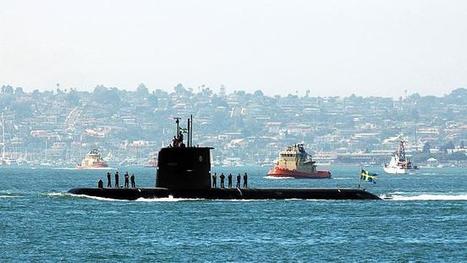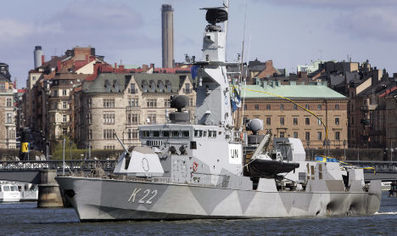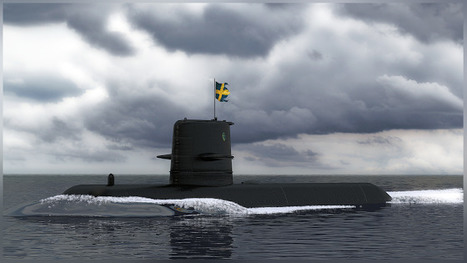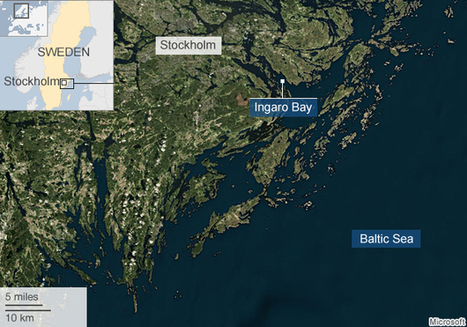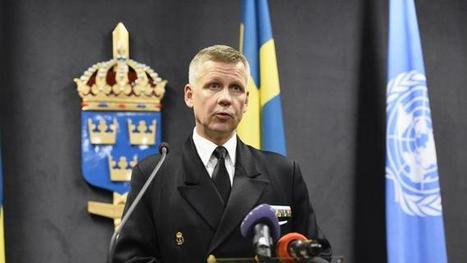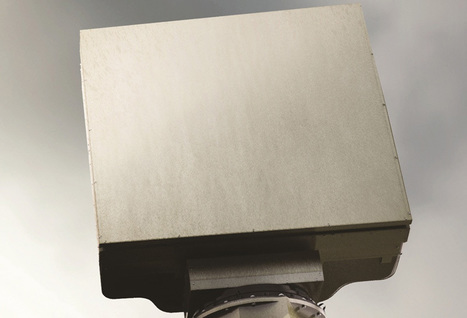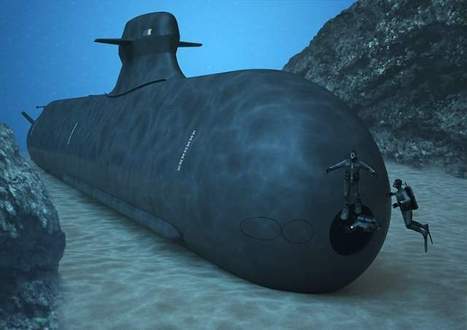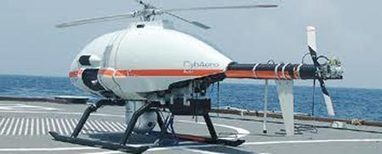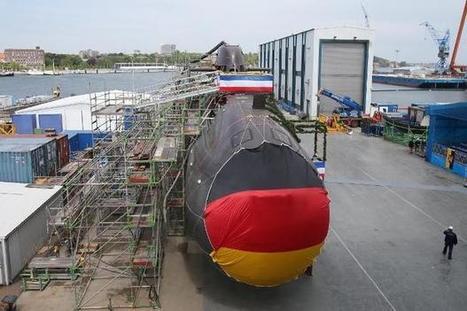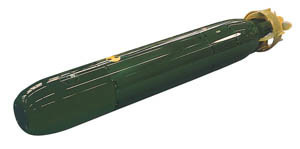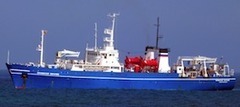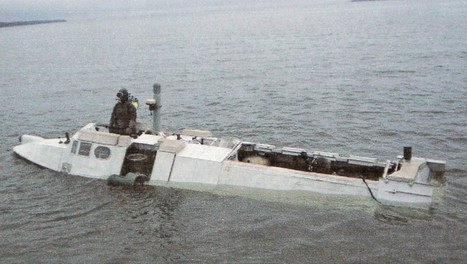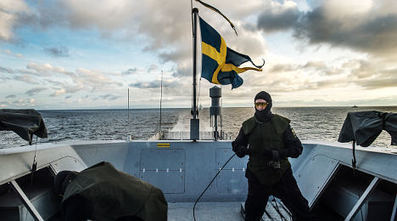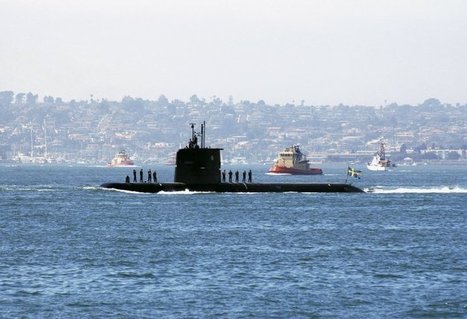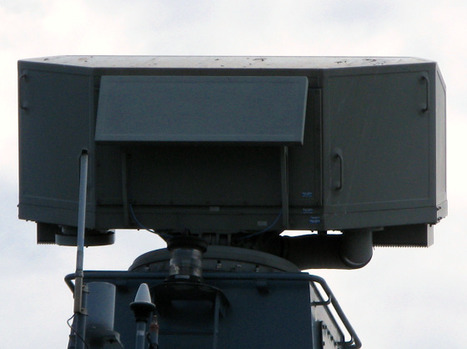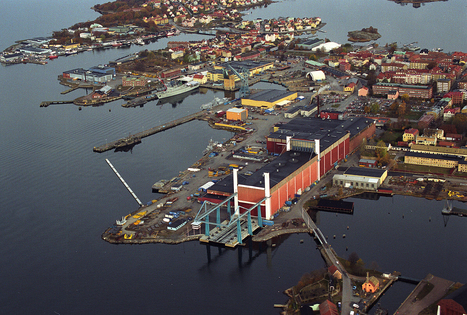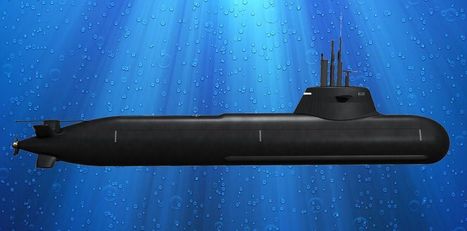 Your new post is loading...

|
Scooped by
Patrick H.
|
SwedEN has accused the Abbott government of spreading lies about its submarine building capability. The head of Sweden’s defence purchasing agency, Lena Erixon, has written to her counterpart at the Defence Materiel Organisation in Canberra, Harry Dunstall, to protest about the denigration of Sweden’s submarine industry led by Prime Minister Tony Abbott. Ms Erixon also revealed that at no stage had Australian officials requested detailed design details from Sweden or included any technical experts in various government delegations to visit the country. Mr Abbott told Parliament that only France, Germany and Japan could build the submarines. “The last Australian submarine came off the production line in about 2001 … the last Swedish submarine came off the production line in 1996, so it’s almost two decades since Sweden built a submarine,” Mr Abbott said. Ms Erixon strongly objected to that assertion saying that Sweden had maintained a “full capacity to design and build submarines both for Sweden and fore export over the last 20 years.” “To state that we would offer obsltete technology from the 1960s and 1980s is simply not true,” she said. Sweden was excluded from the process to provide Australia’s future submarine despite the fact that the navy’s existing submarine fleet is based on a Swedish design from Saab-Kockums. The $20 billion plus contest will be conducted between Japan, Germany and France. The strongly worded letter dated March 2 accesses Australia of ignoring the possibility of a low risk and low cost partnership between the two nations to build the future submarine. Ms Erixon said Sweden had delivered 11 submarines since 1996 including six completely rebuilt boats equipped with Air Independent Propulsion for the Singapore Navy. She said Sweden respected Australia’s decision but added that a new design based on Collins would “be the path of lowest cost and least risk”.

|
Scooped by
Patrick H.
|
Sweden's Defence Minister Peter Hultqvist has announced that the country's navy is upgrading its fleet of ships in order to improve its ability to locate rogue submarines in Swedish waters, following a huge search for a foreign vessel last autumn. Peter Hultqvist announced on Thursday that the government planned to boost protection from potential intruders in Swedish waters, by increasing defence spending by six billion kronor ($696 million) between 2016 and 2020. "Submarine hunting is a priority. We've had incidents showing that it is very important to have an increased capacity for anti-submarine warfare. We must do what we can to maintain and develop our skills. It is very important to protect Sweden's sovereignty," Hultqvist told Swedish newspaper Dagens Nyheter ahead of a media briefing. He added that Sweden's navy would take part in more military exercises, naval ships would get larger crews and ships and boats would be taken out of action if they were not seen to be suitable for use in the current climate. Two key military ships, Gävle and Sundsvall, are set to be significantly modernized with new sensors and other technical equipment designed to help Sweden better spot submarines in its waters. Sweden will also return troops to Gotland in the Baltic Sea, following a decade-long absence from the waters. Around 150 soldiers are set to be stationed on the island which is Sweden's largest and lies between the Nordic nation and Latvia. "We are devoting a considerable sum of money to this mid-term modification," said Hultqvist. But critics argue that the six billion kronor pledge is much less than the armed forces need to modernize their fleet and that the Swedish military is set to come under increasing financial pressure when government plans to raise payroll taxes for employers hiring young people come into action. The Chairman of the Parliamentary Defence Committee, Allan Widman from the centre-right Liberal Party, told the TT news agency: "It's too little money too late in the [parliamentary] term". According to Swedish newspaper Svenska Dagbladet, the armed forces asked for 16 billion kronor. However the publication says that the finance ministry initially offered two billion kronor, so the figure released on Thursday is an improvement on that. Sweden has historically portrayed itself as neutral, but the country's defence capabilities have been called into question since last October's submarine hunt and as Russia's military presence in the region continues to grow. Last month, Estonia-based international think tank International Centre for Defence and Security (ICDS) warned that Sweden might not be able to defend itself against Russia, should its Baltic neighbour become more aggressive in future. Sweden has already announced closer military cooperation with both Finland and Denmark, but has so far ruled out joining Nato. A bill on the proposed fresh spending will be introduced to parliament at the end of April and is expected to be passed following an agreement between the centre-left coalition and the country's centre-right Alliance parties to cooperate on security and defence issues.

|
Scooped by
Patrick H.
|
Defence and security company SAAB has selected a cutting-edge Kongsberg Maritime hydroacoustic package for installation on two Swedish A19 submarines. The delivery will consist of SA9510S Mine Avoidance and Navigation Sonar for submarines and the leading EM 2040 Dual RX multibeam echosounder.
The main purpose of the SA9510S sonar is to detect mines, obstacles and the sea-floor in a wide swath ahead of the submarine. The sonar generates target warnings or alarms with sufficient time available to perform an avoidance manoeuvre. It is a vital tool providing information to crew for bottom navigation purposes and for submerged navigation. The SA9510S sonar has the ability to detect and display the bottom profile in several selected horizontal directions in front of the submarine. Mine-seeking and submerged navigation can be performed simultaneously.
The EM 2040 Dual RX to be delivered is an enhanced version of the leading EM 2040 multibeam echosounder system. The EM 2040 Dual RX features two TX-Transmitters and two RX-Receivers and is designed for mapping in shallow areas at higher speed. It will provide A19 crews with accurate survey data and excellent range performance (both depth and swath width) at the highest resolution available in the market.
“With this sonar solution selected for both the Swedish submarines and Norwegian submarines, Kongsberg Maritime will have delivered active navigation sonars to the two leading submarine nations specialising in operation in shallow water,” comments Thomas Hostvedt Dahle, Product Sales Manager Naval sonars in Kongsberg Maritime. “This contract features our state-of-the-art navigation and avoidance sonar in addition to our flagship multibeam system. It strengthens Kongsberg Maritime’s position as a leading supplier of sonars with special capabilities for operation in littoral waters, whilst demonstrating the effectiveness of our standard products adapted for military operations.”

|
Scooped by
Patrick H.
|
Stockholm - La Suède a mis fin vendredi aux recherches d'un sous-marin ou autre bâtiment "probablement étranger" qui s'est aventuré près de Stockholm, et que sa Marine a cherché en vain pendant une semaine. Cette incursion dans les eaux suédoises devrait probablement rester un mystère, tout comme les autres, réelles et supposées, de sous-marins pendant la guerre froide, puisque la Marine a arrêté ses recherches. Après le déploiement spectaculaire de plus de 200 hommes, de bateaux furtifs, des dragueurs de mines, l'homme qui a commandé les opérations, le contre-amiral Anders Grenstad, semblait avoir peu de certitudes. "L'évaluation des forces armées est qu'à l'intérieur de l'archipel de Stockholm s'est produite une activité sous-marine probablement étrangère", a-t-il déclaré lors d'une conférence de presse à Stockholm. "Cela peut avoir été une petite embarcation", a-t-il ajouté, précisant qu'on pouvait exclure un "sous-marin conventionnel". "Nous estimons qu'il y en a eu au moins un [un bâtiment], au vu des images que nous regardons pour l'instant", a affirmé l'officier, soulignant que même le nombre n'était pas sûr. Toutes les "observations" de cette "activité sous-marine" sont venues de citoyens, tandis que les militaires n'ont rien vu. Les recherches ont été effectuées au plus près à une trentaine de kilomètres de Stockholm, capitale à l'est de laquelle se trouvent quelque 30.000 îles, îlots et récifs, dont une partie habités. Les endroits pour y cacher un sous-marin sont innombrables. - Pas de preuve accusant la Russie - La Suède s'est passionnée pour cette affaire, qui rappelait les années 1980, où l'URSS était régulièrement soupçonnée d'aller explorer les environs de ses bases navales sur la mer Baltique. Tous les soupçons se sont encore tournés vers la Russie, sachant que la Baltique n'a pour riverains, outre elle et la Suède, que la Finlande, pays ami avec lequel la Suède a une coopération militaire étroite, et des membres de l'Otan (Danemark, Allemagne, Pologne, Lituanie, Lituanie et Estonie) qui n'auraient probablement pas laissé la Suède dans le flou aussi longtemps. Moscou est resté discret sur cette affaire. Lundi, une source au sein du ministère de la Défense citée par l'agence Interfax a estimé qu'il s'agissait d'un "sous-marin à propulsion diesel-électrique néerlandais Bruinvis qui effectuait la semaine dernière" des exercices près de Stockholm. Les Pays-Bas avaient aussitôt démenti, soulignant que le sous-marin en question avait quitté la zone depuis longtemps. Pour la Marine suédoise, il n'y a pas de preuve qu'une embarcation russe se cache derrière ce mystère. "Je ne veux pas commenter ce que dit la Russie, nous n'avons pointé du doigt aucune nation", a rappelé le contre-amiral. Le travail n'est pas fini. Les militaires continuent d'analyser les plus de 250 courriers électroniques et coups de téléphone reçu après l'appel à témoins. Vendredi, les forces armées ont décidé de conserver dans la zone de recherche de "plus petites unités terrestres avec des missions particulières", ont-elles indiqué dans un communiqué. Mais "à 8 heures vendredi matin la majeure partie de l'opération marine de renseignement qui était en cours dans l'archipel de Stockholm depuis vendredi dernier a été arrêtée", ont-elles précisé. D'après la Marine, cette semaine de recherches aura coûté environ 20 millions de couronnes (2,2 millions d'euros). Pour les experts de la défense en Suède, l'affaire va obliger le gouvernement à revoir pas mal de ses conceptions. "Puisque l'environnement de la politique de sécurité a maintenant changé et que les menaces de +puissances étrangères+ deviennent plus importantes, il faut aussi une nouvelle vision et une planification militaire adéquate", a estimé Lars Nicander, de la Haute école de défense suédoise, dans une tribune publiée par le quotidien Svenska Dagbladet.

|
Scooped by
Patrick H.
|
L'opération lancée vendredi dernier par la Suède en mer Baltique pour trouver un sous-marin "étranger" va se poursuivre avec des effectifs réduits. L'armée suédoise a annoncé mercredi que l'opération d'envergure lancée pour trouver un sous-marin "étranger" allait se poursuivre avec des effectifs réduits. Stockholm admet que les forces armées n'ont encore rien trouvé de probant dans les eaux autour de la capitale. "L'opération continue et entre partiellement dans une nouvelle phase (...) Une partie de nos unités marines va rejoindre le port pour entretien", a expliqué à la presse le directeur de la communication des Forces armées, Erik Lagersten, depuis la base navale de Berga, près de Stockholm. Ces unités "restent en état d'alerte", a-t-il ajouté. L'opération va se poursuivre avec des unités terrestres, aériennes et marines dont le nombre n'a pas été précisé. De vendredi à mercredi, elle mobilisait plus de 200 hommes, des bateaux furtifs, des dragueurs de mines et des hélicoptères. "Nous avons les ressources exigées pour accomplir notre mission", a affirmé M. Lagersten, refusant de parler de réduction des moyens. L'opération a été déclenchée vendredi après qu'un témoin eut rapporté avoir vu un "objet fabriqué par l'homme" dans l'eau. Les Forces armées n'ont pas elles-mêmes constaté d'activité sous-marine dans l'archipel de Stockholm et la mer Baltique, mais fondent leurs recherches sur cinq observations du grand public jugées crédibles. Relent de guerre froide "Nous recherchons quelque chose ou quelqu'un qui enfreint l'intégrité territoriale de la Suède. C'est tout à fait inacceptable", avait déclaré mardi le contre-amiral Anders Grenstad, promettant de poursuivre les recherches jusqu'à nouvel ordre. "Notre objectif maintenant est de les forcer à sortir de l'eau, quoi que ce soit (...) en ayant recours à la force, si nécessaire", avait menacé pour sa part indiqué le chef d'état-major Sverker Göranson. La Suède s'est passionnée pour cette affaire qui rappelle les maintes autres incursions, réelles ou supposées, de sous-marins près des côtes suédoises pendant la guerre froide. La Russie a nié toute implication, indiquant que le sous-marin recherché était néerlandais, une affirmation aussitôt démentie par les Pays-Bas.

|
Scooped by
Patrick H.
|
Naval vessels searching Swedish waters for a suspected foreign submarine are focusing on a bay near the capital Stockholm on the fifth day of the biggest such operation in years. Ships equipped to detect submarines are among at least five vessels searching Ingaro Bay. One Swedish newspaper said that a ship had "made contact" but there was no official comment on the report. Russia has denied that any of its vessels are involved. A Russian oil tanker has been sailing in international waters nearby, raising suspicion that it was there to help a submarine in difficulty. Russia has several submarines based in Kaliningrad, a Russian enclave bordered by Poland and Lithuania and facing out to Sweden, as well as a much bigger force near Murmansk on the Kola Peninsula. The supreme commander of Sweden's armed forces, Sverker Goransson, told a news conference that it was "too damned bad that someone or some thing is inside our territory in this way", indicating that the military was convinced that something was present. He said there had been further observations in the past 24 hours and the military would comment on them later. In another development, Swedish Prime Minister Stefan Lofven announced his government would increase spending on defence in its budget on Thursday. "We agree on a broad basis between many parties in Sweden in the Swedish parliament that we need to increase our capacity, meaning that we need to put more resources into defence," he said on a visit to the Estonian capital Tallinn. Misinformation Among ships in Ingaro Bay were the Trosso, the Stockholm and the Visby, which have advanced equipment to look for submarines, Swedish media report. Reporting the "contact", Dagens Nyheter said it could not reveal its source for the information or explain exactly what the military meant. Swedish public radio reported that the military had not commented on the report. Earlier, the military admitted giving out misleading information about the location of a picture widely circulated since the search began. A Swedish military spokesman said the wrong information had been released about the grainy photo, which shows a dark object at sea, surrounded by foam, "so as not to aid a foreign power". An order that private boats stay at least 10km (six miles) away from the search operation was removed on Monday but airspace above the search area remains closed to civilian flights at low altitude, Swedish radio reports. Soviet submarine sightings during the Cold War caused security alerts in Sweden in the 1980s. There have been three reported sightings of a submarine west of the capital, Stockholm, since Thursday. Local media said Sweden had also intercepted a distress signal in Russian. Trout fishing Meanwhile, a man whose presence in the search area raised suspicions has turned out to be a Stockholm old age pensioner out fishing for trout. Speaking to Expressen newspaper, "the man in black" said: "I saw there were a lot of military ships out there... A friend called and told me that I was the picture in the newspaper." Russia's official government newspaper, Rossiiskaya Gazeta, questioned whether there was any submarine at all. "Either Sweden's echo location equipment is working badly or, as the old saying goes, the eyes of fear see danger everywhere," it remarked. A Russian-owned oil tanker, the Concord, has been circling near Swedish waters for days, giving rise to suspicions that it is there to resupply a submarine. However, Anders Nordin at the Swedish Coast Guard told Swedish news agency TT that its journey was consistent with normal tanker movements.

|
Scooped by
Patrick H.
|
STOCKHOLM (AP) — Sweden's military on Friday sent naval vessels, aircraft and home guard forces to investigate reports of "foreign underwater activity" in the Stockholm archipelago. The Armed Forces said they launched an intelligence operation in the archipelago after receiving information "from a credible source." Armed Forces spokesman Jesper Tengroth wouldn't say whether a submarine had been sighted or give any other details. Chief of operations Jonas Wikstrom told reporters "a few hundred" people were taking part in the search. The operation was reminiscent of the Cold War, when Sweden's armed forces routinely hunted for Soviet submarines in its waters. In 1981, a Soviet sub carrying nuclear weapons got stranded off Sweden's southeastern coast, causing an 11-day diplomatic standoff before Swedish authorities allowed the submarine to return home. Swedish officials wouldn't speculate on what foreign power could be behind the suspected intrusion Friday. Sweden's Foreign Ministry last month summoned the Russian ambassador to protest a Swedish air space violation by two Russian military aircraft.

|
Scooped by
Patrick H.
|
ARLINGTON, Va. — The company that provides the multipurpose radar for the Austal-built Independence-class littoral combat ship (LCS) is offering a new active electronically scanned array (AESA) radar for the U.S. Navy’s future small surface combatant, one of a family of six radars developed by the company to meet the needs of surface ships. Sweden-based SAAB has invested a significant amount of its internal research and development funding to develop the AESA radars, which use gallium nitride array technology. One of the six radars is the Sea Giraffe 4A radar, an AESA version of the S-band AN/SPS-77 radar used on the Independence class. The new radar uses a 2-meter by 2-meter array. It is a rotating antenna but has a stop-and-stare capability. Like the SPS-77, the Sea Giraffe 4A would be delivered by SAAB Defense and Security LLC in Syracuse, N.Y. The radars would be built in Sweden but assembled in Syracuse using U.S. workers and shipped to the customer from there, said Erik D. Smith, vice president and general manager Saab Defense and Security. The company also would provide full logistics support for life-cycle sustainment of the radar. Sensis responded to the Navy’s request for information for technology for the future small surface combatant, a follow-on ship to the LCS. The company also considers the radar applicable to the U.S. Coast Guard’s Offshore Patrol Cutter. The Sea Giraffe 4A has been ordered by one international customer for delivery in 2016. Smith declined to identify the customer. The new radars are already developed and ready for production and governments would not need to invest in their development, Smith said. The radars use the same back-end processing equipment, but use different arrays and software according to mission requirements. SAAB’s radar family represents a different business model than the traditional industrial approach of a company responding to a requirement and then developing a solution with government funding. SAAB is able to offer a selection of six radars as fully developed items that could be installed on a wide range of platforms according to the mission capabilities desired by the customer.

|
Scooped by
Patrick H.
|
BAE Systems has been awarded a contract to produce and deliver four 57 Mk3 Naval Guns to the Mexican Navy. “This contract award further strengthens our strong position in the naval guns market,” said Lena Gillström, managing director of Weapon Systems, Sweden, at BAE Systems. “This competitive win shows that BAE Systems’ world-leading 57mm naval gun and ammunition systems continue to be selected as the best solution for both new and existing customers around the world.” The 57 Mk3 gun is proving to be a successful product for various customers. In addition to Mexico, the 57 Mk3 is also in service with Navies and Coast Guards in the United States, Canada, Sweden, Finland, and Malaysia. The 57 Mk3 gun can fire four rounds per second and can switch immediately between ammunition types to deliver seamless targeting of air, land, and sea-based threats and provide superb survivability and tactical freedom at all levels of conflict. Series production begins immediately, with gun deliveries beginning in 2015 and continuing through 2017. Final assembly will take place at BAE Systems’ facility in Karlskoga, Sweden.

|
Scooped by
Patrick H.
|
Selon le quotidien Handelsblatt, la vente des deux chantiers navals suédois de TKMS (Malmö et Karlskrona) à Saab n’est pas vue d’un bon œil à Berlin : le gouvernement allemand bloque le dénouement de ce très gros différend germano-suédois. Ces derniers mois, les Suédois avaient perdu confiance en TKMS, accusé d’avoir racheté Kockums pour mieux l’étouffer. La DGA suédoise (FMV) avait demandé à Saab de prendre en main la construction des futurs sous-marins. L’administration avait annoncé qu’elle ne commanderait plus de bâtiments aux Allemands. Finalement, TKMS baissait les bras et signait un MoU avec Saab en vue de la vente de ses chantiers. Dans la foulée, une mystérieuse descente de l’armée avait lieu le 8 avril au chantier de Malmö. Il y a deux semaines, le quotidien the Dagens Nyheter révélait l’objet de la razzia : la FMV a fait saisir certains éléments des moteurs stirling qui équipent les sous-marins (classe Gotland), par crainte de voir quelques technologies prendre le chemin de l’Allemagne. Malgré ce climat, la vente ne semble pas déplaire au patron de ThyssenKrupp, Heinrich Hiesinger, qui se bat pour remettre son conglomérat à flots, envisageant de restructurer l’activité navale. Mais c’était sans compter la méfiance du gouvernement allemand. Celui-ci craint que cette vente conduise à livrer des secrets technologiques aux Suédois, particulièrement en ce qui concerne la propulsion anaérobie par piles à combustible. Chez ThyssenKrupp, on rappelle pourtant que les Suédois travaillent sur d’autres technologies de propulsion et l’on assure qu’ils n’ont jamais eu accès aux brevets allemands. Berlin n’en doute pas moins. Selon un fonctionnaire de la défense cité par Handelsblatt, « on peut supposer que les managers suédois de ThyssenKrupp ont une bonne vue d’ensemble sur la technologie des piles à combustible ». La maison mère de TKMS négocie donc serré avec l’administration de la Défense et les politiques berlinois pour tenter de régler le plus rapidement possible une vente qui pourrait lui rapporter deux milliards d’euros. Cet argent, le géant de l’acier en a grand besoin pour assurer l’avenir de l’ensemble du groupe. D’aucuns disent d’ailleurs que la multinationale n’aurait pas seulement le désir de se débarrasser de ses chantiers suédois et que la restructuration pourrait être plus profonde que prévue. Informations qui ne sont pas passées inaperçues du côté de DCNS, qui rêve toujours d’un « EADS de la mer ». Le quotidien allemand cite même un émissaire français qui espère « avoir une nouvelle occasion de convaincre ThyssenKrupp avec notre vieille idée ».

|
Scooped by
Patrick H.
|
Swedish firm CybAero recently sold a number of its APID 60 helicopter UAVs (unmanned aerial vehicles) to the Chinese coast guard, which plans to use the unmanned aerial vehicle aboard customs vessels to combat smuggling, reports the Washington-based Strategy Page on Apr. 18. Designed as a 180-kilogram unmanned helicopter, the APID 60 is capable of carrying a 75-kilogram payload for up to six hours per sortie. It has a max speed of 150 kilometers per hour, and a max altitude of 3,000 meters. The APID 60 can also be operated up to 200 kilometers from the control station on a ship or land, and costs more than 75% less than a manned helicopter to operate, the report said, adding that it is just as effective for reconnaissance. China has designed its own helicopter UAVs such as the Z-5, according to the report, but the quality and performance of these drones cannot match the APID 60. The Z-5 designed in 2011 is a 437-kilogram drone that can only carry a payload of up to 100-kilograms for three hours. In addition, the Z-5 can only be operated 100 kilometers away from a control station. Unlike most helicopter UAVs, the APID 60 was built from an original design instead of taking an existing small-size helicopter and turning it into a drone. The APID 60 can be seen as an upgrade version of the APID 55, which was designed for the United Arab Emirates (UAE), Strategy Page said. The UAE continues to manufacture the APID 55 under license and exports it to other nations for coast patrol missions.

|
Scooped by
Patrick H.
|
SWEDISH defence giant Saab is making a bold, secret play for a slice of Australia’s $30 billion future submarine project. As Federal Government placed all options for the navy’s future submarine back on the table this week, News Corp Australia can reveal that Saab and the Swedish Government have been engaged in secret talks with the Defence Department about the design of the new boats. A Swedish delegation travelled to Canberra in March for first round talks. Sweden has along history in submarines but it moved away from the business about 15 years ago when its shipbuilder Kockums — the company that designed the Collins Class submarine — was sold to German company Thyssen Krupp MS (TKMS). The Swedish Government last month cancelled a deal with Kockums to buy its future submarine and since then it has contracted Saab to examine options for the nation’s sub-surface fleet. One option is buying the submarine builder back from TKMS and possibly expanding operations in Australia. Saab has hired almost 100 submarine experts from Kockums during the past month and its spokesman Anders Carp hinted that the hi-tech defence company could make a bid for Adelaide based submarine maker ASC if an when it came up for sale. “We are impressed with the company,” Mr Carp said. When asked if Saab might buy the company and build the Swedish submarines in Adelaide he did not rule it out and he added that 80 per cent of the company’s popular Gripen fighter jet was built elsewhere. He said discussions between Saab and Australia had involved the design of the vessel and not the combat management systems. Australia favours an American combat system. Saab already has crucial safety systems installed in the Collins Class fleet. Mr Carp said the option for an evolved Collins Class vessel would be the most cost effective solution for Australia. Saab executives met with government staffers on the sidelines of this week’s ASPI submarine conference in Canberra. Defence Minister David Johnston told the conference that all options were on the table as the government developed its first Defence White Paper for release early next year. He said the favoured option was to build the boats in Adelaide but “not at any cost”. Options also include a possible partnership with the world’s biggest and most capable diesel-electric submarines the 4200-tonne Japanese Soryu Class boat. Discussions with the Japanese are well advanced, but Senator Johnston refused to elaborate saying they were “commercial-in-confidence”. There is strong interest in the Swedish designed Stirling engine and its air independent propulsion system that allows the vessel to remain submerged for long periods of time. The biggest drawback with a diesel-electric boat compared with a nuclear vessel is the need to “snorkel” for air to feed the diesels that recharge the batteries. The advantage of conventional powered vessels is their silence and that they can operate in shallower waters than nuclear submarines.

|
Scooped by
Patrick H.
|
It’s a war without a shot being fired, not fought on the high seas, but in the corporate boardrooms of two defense contractors. On the one side is Sweden’s SaabGroup, a defense contractor looking to establish a submarine-building unit. On the other side is Germany’s ThyssenKrupp, trying to dominate northern Europe's submarine-building industry. In the most recent development, the Swedes have been luring ThyssenKrupp employees to their side, prompting the Germans to offer them a bonus equal to a month’s salary to stay, according to an article in the Sweden edition of The Local. Not to be confused with the automaker, Saab was founded in 1937 as an aircraft manufacturer. In 1947 it expanded into automobile manufacturing, creating the iconic Saab automobile. It had been the parent company until 1990 when the carmaking division began operating as a separate entity. The trouble with ThyssenKrupp began in 2005, when the German defense contractor bought the Kockums Karkskrona shipyard, in southern Sweden, where for centuries ships for the Swedish navy had been built. Kockums had been a direct competitor of ThyssenKrupp, and it quickly became obvious that they had acquired the Swedish company, not to expand its capability, but to eliminate a competitor. “The purchase of Kockums wasn’t aimed at consolidating the naval industry and creating synergies, but getting rid of a competitor,” said an unidentified German source reported in The Local.Things began to heat up in 2011 when ThyssenKrupp CEO Hans Christoph Atzpodien did not allow Kockums to bid on a project to build two submarines for Singapore, even though the Swedish company had a long-standing business relationship with that country. Last year, it blacked a deal between the Swedish shipyard and Australia by purchasing Australian Naval Technologies, and claimed they “could do the same job as Kockums could have done on its own.” To add insult to injury, the German firm last year decided to get rid of the old Swedish name and change it to the official German title ThyssenKrupp Marine Systems (TKMS). It was at about this point that officials in the Swedish government began to get concerned. “Submarine-building capabilities are essential for our armed forces and our ability to defend ourselves,” said Allan Widman, a member of parliament and the Liberal Party’s defense spokesman. Over the past few weeks there have been rumors that the Saab Group has been looking into buying Kockums back into Swedish hands, but neither the Swedes nor the Germans are commenting. It’s now looking as though the SaabGroup is planning to establish a submarine-building division of its own, and it’s actively recruiting Swedish employees of ThyssenKrupp to go to work for them. So far, 200 ThyssenKrupp employees have gone over to the SaabGroup, and even more say they would be interested. To stop the bleeding, the Germans made the bonus offer, on the condition that at least 40 percent of its employees stay.
|

|
Scooped by
Patrick H.
|
Sweden is to buy two new submarines from constructors Saab Kockums, it was announced today. The A26 subs are to be delivered by 2022 and will cost up to SEK 8.2 billion, news agency TT reports. "This is the biggest single decision when it comes to economic investments that we will make during this parliament", Defence Minister Peter Hultqvist told TT. The decision, to be formally made by the cabinet on Thursday, is to "ensure Swedish submarine capability past 2030", the minister adds. "These are the next generation of submarine. These submarines will be very hi-tech", he says.

|
Scooped by
Patrick H.
|
Key Points - Saab receives SEK175 million (USD20.8 million) FMV order to develop new torpedo and to support other underwater systems
- Order placed within framework of 2014 Letter of Intent signed between Saab and the FMV
Swedish defence and security company Saab has received orders from Sweden's defence materiel administration (FMV) for continued development of the New Lightweight Torpedo (NLT) plus maintenance support for the Hydra sonar and other underwater systems, the company announced on 20 February. The order, valued at approximately SEK175 million (USD20.8 million) according to the Saab statement, has been made within the framework of a Letter of Intent (LoI) signed between Saab and the FMV on 9 June 2014.

|
Scooped by
Patrick H.
|
EXCLUSIVE: Swedish defence giant Saab Group has launched an audacious bid to build the Australian navy’s future submarine. In a move that could mean thousands of jobs for South Australia and other states, industry sources have told News Corp Australia that Saab Group has presented a three-pronged strategy to secure the $20 billion plus Federal Government contract. It includes a lower price than its competitors and a smooth flow of Japanese submarine technology from the Soryu Class boat, because Sweden is a partner in the Japanese project. There will also be substantial technology transfer and industrial offsets for Australia, including jobs in Adelaide during the build phase, and a raft of new defence industries Saab Group recently reclaimed former Swedish submarine builder Kockums from German giant Thyssen Krupp Marine Systems (TKMS) and is moving fast to win the $20 billion plus Australian contract. A spokesman for Defence Minister David Johnston confirmed that a Swedish bid had been received. “We are aware that an unsolicited proposal was sent to Defence,” the spokesman said. The company’s global chief executive officer Hakan Buskhe will publicly launch the plan in Fremantle next Tuesday (NOV11) during the Submarine Institute of Australia’s centenary conference. Kockums was the design and build partner for the navy’s controversial Collins Class submarine and Saab Kockums wants to extend the relationship into the next generation of conventionally powered vessels. The company builds the Gotland Class submarine — the first boat in the world equipped with air independent propulsion — that is widely regarded as one of the most stealthy submarines in the world. During recent exercises with the US Navy off California HMS Gotland “sank” a nuclear powered submarine as well as the pride of the US Fleet the aircraft carrier USS Ronald Reagan. Her crew captured periscope images of the carrier to prove the “kill”. According to well-placed sources heavy lobbying and fears about an electoral backlash in South Australia have pushed the government to back away from earlier plans to simply buy the Japanese Soryu Class boat straight “off the shelf”. Both the Swedes and Germans are offering brand new vessels to meet the navy’s key requirements of size, range and stealth. News Corp Australia also understands that the government is set to launch a project definition study before the end of 2014 for the nation’s biggest defence project that includes Japanese, Swedish, German and French options. Treasurer Joe Hockey confirmed that an announcement was imminent. “We need to decide quickly and whatever we do decide will be in the best interests of the entire nation,” Mr Hockey said. It is understood that Mr Buskhe will meet with Senator Johnston next week to discuss the Saab bid.

|
Scooped by
Patrick H.
|
Après avoir nié la présence d’un sous-marin en perdition au large des côtes suédoises, Moscou a dépêché un bateau d’exploration des fonds marins, le “Professor Logachev”, qui emporte avec lui un mini sous-marin de sauvetage. Particulièrement préoccupé, le Kremlin aurait envoyé à son bord un émissaire du premier cercle pour superviser les opérations.
La présence — jugée ‘‘très probable’’ par le CEMA suédois — d’un submersible “indéterminé”, à 40 km du centre de Stockholm, a relancé le débat sur l’insuffisance de moyens accordés à la Défense. Le projet de budget 2015 ne contiendra pas d’annonces majeures dans le domaine, mais il est probable que cette nouvelle intrusion ait des conséquences. Car elle a mis en lumière les déficiences de la défense suédoise en termes d’équipements.
Le royaume ne dispose plus d’hélicoptères équipés pour une chasse au sous-marin. «Les appareils qui participent aux opérations de recherche (depuis le 17 octobre) sont prévus pour le transport de troupes, alors qu’il faudrait des hélicoptères équipés d’hydrophones et autres équipements de détection», note un expert de l’Ecole militaire suédoise. La dizaine d’appareils spécialisés dont le pays était équipé, des Boeing Vertol 107, ont été remisés ou vendus en 2011. La livraison de leurs successeurs avait déjà pris du retard et, depuis, les choses ne se sont pas arrangées : ce n’est que vers 2020 que la flottille de NH90 commandés (en 2001) à NHIndustries sera opérationnelle. Sur 18 unités, cinq seront dédiées à la recherche de sous-marin. Ce retard s’explique, en partie, par une modification de la hauteur de la cabine demandée par Stockholm.
Alors que la plus grosse opération suédoise de recherche de sous-marin depuis la Guerre froide se déroulait, des experts pointaient d’autres déficiences. L’artillerie côtière a été démantelée en 2000 et le régiment amphibie qui l’a remplacée a vu ses moyens réduits. «Or il est important de pouvoir être flexible et de pouvoir prendre pied sur les îles pour faire face aux forces spéciales susceptibles d’être débarquées par des sous-marins ennemis», constate un autre expert.

|
Scooped by
Patrick H.
|
Alors que les médias français sont très circonspects quant à la présence d'un sous-marin russe dans les eaux suédoises, les autorités du royaume viennent quant à elles d'élargir le périmètre de recherche et d'en interdire tout survol et toute navigation. Les questions qui se posent sont nombreuses 4 jours après le début des recherches lancées en Suède pour déterminer la nature du navire sous-marin photographié dans l'archipel de Stockholm. Selon les dernières informations, la police serait en outre à la recherche d'un mystérieux individu vêtu de noir et portant un sac à dos, répéré non loin du lieu d'observation du mini sous-marin, sous-marin qui pourrait, selon les experts suédois, être un Triton NN. Le Triton NN est une navire hybride, mi-vedette rapide (30 à 40 noeuds), mi-sous-marin, destiné à l'infiltration de commandos. Il est notamment mis en oeuvre par une unité de la base navale de Kaliningrad. Il est relativement similaire dans son concept au Seal Carrier britannique dont disposent les commandos suédois. Lancé depuis une unité en mer, il navigue alors à grande vitesse pour se rapprocher des côtes, avant de plonger pour déposer des plongeurs en toute discrétion au lieu voulu. Il est à noter que cette chasse au sous-marin "russe" intervient près plusieurs incidents survenus dans la région, notamment l'enlèvement par les commandos russes d'un garde frontière estonien accusé d'espionnage, mas aussi l'arraisonnement inexpliqué et répété d'un navire de recherche océanographique finlandais, dans les eaux internationales.

|
Scooped by
Patrick H.
|
A Russian distress call prompted Sweden's hunt for foreign underwater activity in the Stockholm archipelago, newspaper Svenska Dagbladet (SvD) reports. Traduction "le Portail des sous-marins": Un appel de détresse russe a provoqué le lancement d’une opération de recherche par le Suède pour des activités sous-marines étrangères dans l’archipel de Stockholm. Les services suédois de renseignement ont intercepté jeudi soir un appel de détresse. Puis,14 heures plus tard, vers midi vendredi, un navire étranger a été repéré dans l’archipel de Stockholm. Après qu’elle ait lancé son opération militaire au large de Stockholm, la Suède a intercepté de nouvelles communications, des messages codés relayés par des antennes situées dans l’archipel de Stockholm en direction de l’enclave russe de Kaliningrad. L’armée suédoise a refusé de démentir ou confirmer l’information. Un pétrolier russe, le NS Concord, a été observé faisant des cercles dans les eaux internationales, au large de Stockholm. L’armée suédoise a déployé vendredi des avions et des navires dans l’archipel. L’opération a continué jusqu’à samedi. « Elle se poursuivra jusqu’à ce que nous considérions avoir terminé, » a indiqué Jesper Tengroth, officier de presse de l’armée suédoise. Il a ajouté : « Nous essayons de vérifier l’information que nous avons reçue hier. Elle provient de sources que nous jugeons crédibles. »

|
Scooped by
Patrick H.
|
LINKOPING, Sweden, July 3 (UPI) --Sweden's Defense Materiel Administration has tapped Saab to design a new lightweight torpedo over the next year. The order is worth more than $7.1 million and is part of a letter of intent between Saab and the government on upgrading the underwater capability of the country's armed forces. "We are very pleased and proud to have the continued confidence to deliver torpedo weapon systems to FMV and the Swedish Navy in the commencement of the work to deliver the replacement for Torpedo 45," said Gorgen Johansson, senior vice president and head of Saab's Dynamics business area. Added Agneta Kammeby, vice president and head of Saab's Underwater Systems unit: "Saab Dynamics has over the years established a unique experience and expertise in developing underwater systems for shallow waters and the types of environment that exist in the Baltic Sea. Many of our systems are world leading in its segment, and with this order, we are able to maintain our global leadership position and continue to provide the market with competitive products." Additional details about the order or the envisaged torpedo were not released.

|
Scooped by
Patrick H.
|
ThyssenKrupp Industrial Solutions AG, a company of ThyssenKrupp Group, and Saab AB today entered into an agreement on the sale of Swedish shipyard ThyssenKrupp Marine Systems AB (formerly Kockums) with facilities in Malmö, Karlskrona and Muskö. The purchase price is SEK 340 million (around €37 million). The transaction is subject to the approval of the board and supervisory bodies of the ThyssenKrupp Group as well as the Swedish Competition Authority. In April 2014, the two companies signed a non-binding Memorandum of Understanding on the acquisition of the Swedish shipyard, which has generated substantial losses for years. ThyssenKrupp Industrial Solutions has been pursuing the sale in line with the Swedish government’s publicly stated preference for national naval shipbuilding programs.
ThyssenKrupp is focusing its naval shipbuilding activities in Kiel, Hamburg and Emden. These activities are highly cash generative and contribute reliably to the company’s earnings. With its proprietary air-independent HDW fuel cell propulsion system, ThyssenKrupp Marine Systems is the clear world market leader in the field of non-nuclear submarines.

|
Scooped by
Patrick H.
|
Saab has received contracts worth SEK467 million (USD70.4 million) from the Swedish Defence Materiel Administration (FMV) to generate construction and production plans for the Royal Swedish Navy's next-generation submarines and the mid-life update of two Type A 19 Gotland-class submarines. In parallel, the two the parties announced on 9 June that they had signed a letter of intent (LoI) regarding a framework to sustain the Swedish Armed Forces' underwater capability out to the mid-2020s, with potential orders valued at more than SEK11 billion. This announcement comes as Saab continues negotiations with ThyssenKrupp Industrial Solutions for the acquisition of ThyssenKrupp Marine Systems AB (TKMS AB).

|
Scooped by
Patrick H.
|
Defence and security company Saab extends its surface radar portfolio, with the introduction of five all-new complementary Giraffe radars for land and sea. This strengthens the current product offering but also takes the Giraffe firmly into the long-range air surveillance domain and puts an entirely new capability onto the market. Saab’s combat-proven and highly-regarded surface radar portfolio, including the renowned Giraffe AMB and Arthur radars, has been improved and expanded through the addition of new technologies and designs. Alongside its existing products, Saab is now producing new active electronically scanned array (AESA) radar variants for land and sea. These radars use leap-ahead design techniques that put them in a class of their own in terms of performance and capability. For the first time Saab’s Giraffe radars also offer a solution for long-range air surveillance. There is now a Giraffe option for every air surveillance and air defence application, on land and at sea. Saab has more than 30 years of AESA design experience. This depth of experience –and Saab’s understanding of radar cost, performance, reliability and packaging issues – results in a unique technology solution. Saab’s advanced surface-based radars are highly-effective against multiple ‘difficult’ air targets in the most dense and challenging operational environments. Members of Saab’s surface-based radar family for land and sea now include: Giraffe 1X and Sea Giraffe 1X: short-range radars fitted with an X-band AESA, offering a comprehensive set of 3D functions with impressive performance and flexibility. Giraffe 4A and Sea Giraffe 4A: medium- to long-range radars, combining air surveillance, air defence, sense and warn and weapon locating capabilities in a single, low-footprint S-band AESA-based unit. Giraffe 8A: a long-range S-band AESA radar, including anti-ballistic missile capability, that pushes performance and functionality to a new level. Giraffe AMB and Sea Giraffe AMB: Saab’s existing short- to medium-range surveillance radar and command and control system for ground-based air defence. These combat proven C-band systems have now been enhanced with increased range and coverage. Arthur: Saab’s combat proven C-band medium-range weapons-locating system which detects and locates enemy fire. With 80 units sold to date, the system’s performance and functionality has now been further enhanced. Saab’s In-Service Solutions is another vital part of the overall radar family product offering and is currently contracted by more than 20 customers worldwide. Saab’s radar logistics support removes 100 percent of real-life risks related to cost of ownership and has proven to deliver 98.5 percent long-term mission availability. Finally, Saab also offers a Common Radar Upgrade solution, providing upgrades to or extending the lifetime of customers’ existing (non-Saab) radar systems. Saab is one of the world’s leading radar suppliers with 60 years of experience and more than 3,000 radar systems in operation in 30 countries. Saab serves the global market with world-leading products, services and solutions ranging from military defence to civil security. Saab has operations and employees on all continents and constantly develops, adopts and improves new technology to meet customers’ changing needs.

|
Scooped by
Patrick H.
|
C’est par un communiqué succinct que ThyssenKrupp a fait savoir que des négociations avaient démarré avec le suédois Saab en vue de la vente de sa filiale suédoise Kockums (ThyssenKrupp Marine Systems AB), spécialisée dans la construction de sous-marins et subordonnée à sa division marine ThyssenKrupp Marine Systems (TKMS). ThyssenKrupp n’a pas pris cette décision par pure générosité. En fait, quelques jours auparavant, le gouvernement suédois a tout simplement annoncé qu’il n’achèterait plus de sous-marins à la filiale de TKMS. Certaines sources évoquent le fait que le conglomérat allemand n’avait plus aucun intérêt à conserver cet entité après la victoire à Singapour… ou TKMS a remporté l’appel d’offres pour la vente 6 sous-marins AIP (dont 4 en option). Car côté suédois, il était devenu clair que Kockums était menacé dans son existence par les conditions et blocages imposés par ThyssenKrupp : impossible pour l’entreprise suédoise de briguer dans de bonnes conditions des contrats à l’exportation (notamment à Singapour) ; impossible aussi, à terme, de préserver le savoir-faire suédois dans le domaine des sous-marins, nécessaire pour la sécurité du royaume étant donné les spécificités de la Baltique, redevenue hautement stratégique à cause de la Russie. L’annonce des pourparlers, concrétisée par la signature d’un Memorandum of Understanding entre les deux sociétés, présage donc d’une fin « heureuse » pour une affaire bien mal engagée tant sur le plan industriel que diplomatique. Racheté par le spécialiste allemand des sous-marins HDW (devenu depuis TKMS Kiel) en 1999, « l’alliance n’a pas débouché sur une fusion, ni un partage des activités au sein du groupe », reconnaît un syndicaliste allemand interrogé par TTU. Selon la version des autorités suédoises, et les faits ne leur donnent pas totalement tort, ThyssenKrupp n’a jamais vraiment eu l’intention de partager son savoir-faire ni de pousser les sous-marins de Kockums sur les marchés internationaux. Certains estiment que l’Allemand a tout simplement racheté le Suédois pour le neutraliser. Résultat, au fil des ans, les activités des chantiers de Malmö, Karlskrona et Muskö se sont réduites à de la maintenance, des réparations et à la production de quelques bâtiments pour la marine nationale. L’évolution des effectifs de Kockums témoigne de ce tarissement. De 1 500 salariés au tournant du siècle, ils sont passés aujourd’hui à 900 salariés plutôt sous-occupés. Face à la morosité suédoise, l’effervescence qui règne sur les chantiers allemands de Kiel tranche cruellement. TKMS Kiel affiche un carnet de commandes plein avec 23 sous-marins (bâtiments complets et « kits de montage » compris), 2 600 salariés et un besoin exprimé en personnel d’environ 300 salariés supplémentaires. Pour régler le problème, les représentants de la DGA suédoise (FMV) et sa directrice Lena Erixon se sont déplacés à plusieurs reprises à Berlin et sur la cote baltique, afin de convaincre les Allemands de revendre « leur » chantier. Sans succès. Ce qui a poussé la FMV à entrer en résistance et à abattre la carte Saab d’une manière plus qu’énergique. Face aux attaques de Saab et au durcissement de l’Etat suédois, TKMS a proposé en urgence la construction d’un sous-marin en Suède, l’A26. Le gouvernement souhaite en commander deux exemplaires, pour une entrée en service à l’horizon 2020, en parallèle avec la modernisation d’au moins deux sous-marins de classe Gotland. Tout en annonçant qu’il comptait se renforcer dans tout le secteur naval, Saab avait alors entrepris de débaucher plusieurs dizaines d’ingénieurs et de cadres de Kockums. Ces manœuvres seront suspendues le temps des négociations avec ThyssenKrupp, à en croire le communiqué commun du 14 avril. A Stockholm, les experts ne croient pas en un blocage du rachat par des autorités de la concurrence. Le risque d’achoppement viendrait plutôt du prix que demandera l’Allemand pour, de facto, autoriser la naissance d’un rival de premier ordre dans le domaine des submersibles conventionnels. Le transfert de « blocs de travail » a également été évoqué : « La question s’est révélée difficile étant donné la forte séparation de nos activités et la nécessité pour nous d’obtenir l’accord de nos clients », a expliqué Torben Beckmann, porte-parole de ThyssenKrupp, à TTU.

|
Scooped by
Patrick H.
|
(Infodefensa.com) Helsinki - The Swedish Government has canceled plans to purchase two submarines and modernize other two had signed by the company specializes in submersible Kockums AB , owned by Germany's ThyseenKrupp. According to the Swedish television, the decision is based on the conviction of the Ministry of Defence that the company is unable to fulfill the job. The same sources said that even so, the Swedish Government needs two new submarines and modernize two in service at the Office of Procurement and Material Ministry of Defence has asked the Swedish company Saab a preliminary study on whether she could take place. To fulfill this mandate, the directors of Saab have already started recruiting engineers Kockums , while ThyseenKrupp offers financial rewards to encourage their workers to remain in it. Experts speculate that the Swedish government to support an operation for which Saab repurchase the ownership of the company Kockums AB , now called ThyssenKrupp Marine Systems (TKMS). Officials of the Swedish Ministry of Defence expressed dissatisfaction with the lack of response from TKMS some of his requests, for example, fixing a closed the acquisition of two new submarines price model A26 and modernizing Class Gotland in service. In February 2010, FMV and Kockums AB signed a contract to start the design phase of a new generation of submarine-called A26 - Defense and subsequently confirmed its intention to acquire two units for 2018-19 with the aim of replacing the Södermanland class at the end of its operational life. The directors of ThyseenKrupp studying a reorganization of the company that, among other things, would mean redesigning yards Malmo as specialized small submarines and installation vessels up to 1,000 tons, large units abandoned as submersibles A26 . ThyssenKrupp, through its subsidiary Deutsche Howaldtswerke-Werft (HDW), the shipbuilding division acquired Kockums of Sweden's Celsius AB in 1999. Later, HDW became part of ThyssenKrupp Marine Systems .
|



 Your new post is loading...
Your new post is loading...

